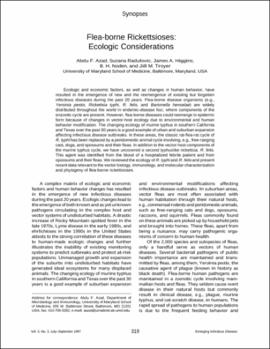| dc.contributor.author | Azad, Abdu F. | |
| dc.contributor.author | Radulovic, Suzana | |
| dc.contributor.author | Higgins, James A. | |
| dc.contributor.author | Noden, Bruce H. | |
| dc.contributor.author | Troyer, Jill M. | |
| dc.date.accessioned | 2022-04-12T13:56:40Z | |
| dc.date.available | 2022-04-12T13:56:40Z | |
| dc.date.issued | 1997-07 | |
| dc.identifier | oksd_noden_fleabornerickettsioses_1997 | |
| dc.identifier.citation | Azad, A. F., Radulovic, S., Higgins, J. A., Noden, B. H., & Troyer, J. M. (1997). Flea-borne rickettsioses: Ecologic considerations. Emerging Infectious Diseases, 3(3), pp. 319-327. https://doi.org/10.3201/eid0303.970308 | |
| dc.identifier.uri | https://hdl.handle.net/11244/335209 | |
| dc.description.abstract | Ecologic and economic factors, as well as changes in human behavior, have resulted in the emergence of new and the reemergence of existing but forgotten infectious diseases during the past 20 years. Flea-borne disease organisms (e.g., Yersinia pestis, Rickettsia typhi, R. felis, and Bartonella henselae) are widely distributed throughout the world in endemic-disease foci, where components of the enzootic cycle are present. However, flea-borne diseases could reemerge in epidemic form because of changes in vector-host ecology due to environmental and human behavior modification. The changing ecology of murine typhus in southern California and Texas over the past 30 years is a good example of urban and suburban expansion affecting infectious disease outbreaks. In these areas, the classic rat-flea-rat cycle of R. typhi has been replaced by a peridomestic animal cycle involving, e.g., free-ranging cats, dogs, and opossums and their fleas. In addition to the vector-host components of the murine typhus cycle, we have uncovered a second typhuslike rickettsia, R. felis. This agent was identified from the blood of a hospitalized febrile patient and from opossums and their fleas. We reviewed the ecology of R. typhi and R. felis and present recent data relevant to the vector biology, immunology, and molecular characterization and phylogeny of flea-borne rickettsioses. | |
| dc.format | application/pdf | |
| dc.language | en_US | |
| dc.publisher | Centers for Disease Control and Prevention (CDC) | |
| dc.relation.ispartof | Emerging Infectious Diseases, 3 (3) | |
| dc.relation.uri | https://www.ncbi.nlm.nih.gov/pubmed/9284376 | |
| dc.rights | This material has been previously published. In the Oklahoma State University Library's institutional repository this version is made available through the open access principles and the terms of agreement/consent between the author(s) and the publisher. The permission policy on the use, reproduction or distribution of the material falls under fair use for educational, scholarship, and research purposes. Contact Digital Resources and Discovery Services at lib-dls@okstate.edu or 405-744-9161 for further information. | |
| dc.subject.mesh | Animals | |
| dc.subject.mesh | Animals, Domestic | |
| dc.subject.mesh | California | |
| dc.subject.mesh | Cats | |
| dc.subject.mesh | Disease Vectors | |
| dc.subject.mesh | Dogs | |
| dc.subject.mesh | Ecosystem | |
| dc.subject.mesh | Humans | |
| dc.subject.mesh | Insect Vectors | |
| dc.subject.mesh | Opossums | |
| dc.subject.mesh | Phylogeny | |
| dc.subject.mesh | Polymerase Chain Reaction | |
| dc.subject.mesh | Rats | |
| dc.subject.mesh | Rickettsia | |
| dc.subject.mesh | Rickettsia Infections | |
| dc.subject.mesh | Rickettsia typhi | |
| dc.subject.mesh | Siphonaptera | |
| dc.subject.mesh | Texas | |
| dc.subject.mesh | Typhus, Endemic Flea-Borne | |
| dc.subject.mesh | Animals | |
| dc.subject.mesh | Animals, Domestic | |
| dc.subject.mesh | Dogs | |
| dc.subject.mesh | Cats | |
| dc.subject.mesh | Opossums | |
| dc.subject.mesh | Humans | |
| dc.subject.mesh | Rats | |
| dc.subject.mesh | Rickettsia | |
| dc.subject.mesh | Rickettsia typhi | |
| dc.subject.mesh | Rickettsia Infections | |
| dc.subject.mesh | Typhus, Endemic Flea-Borne | |
| dc.subject.mesh | Polymerase Chain Reaction | |
| dc.subject.mesh | Ecosystem | |
| dc.subject.mesh | Disease Vectors | |
| dc.subject.mesh | Insect Vectors | |
| dc.subject.mesh | Phylogeny | |
| dc.subject.mesh | California | |
| dc.subject.mesh | Texas | |
| dc.subject.mesh | Siphonaptera | |
| dc.title | Flea-borne rickettsioses: Ecologic considerations | |
| dc.date.updated | 2022-04-07T14:54:23Z | |
| osu.filename | oksd_noden_fleabornerickettsioses_1997.pdf | |
| dc.description.peerreview | Peer reviewed | |
| dc.identifier.doi | 10.3201/eid0303.970308 | |
| dc.description.department | Entomology and Plant Pathology | |
| dc.type.genre | Article | |
| dc.type.material | Text | |
| dc.subject.keywords | Vector-Borne Diseases | |
| dc.subject.keywords | Prevention | |
| dc.subject.keywords | Biodefense | |
| dc.subject.keywords | Infectious Diseases | |
| dc.subject.keywords | Emerging Infectious Diseases | |
| dc.subject.keywords | Vaccine Related | |
| dc.subject.keywords | Rare Diseases | |
| dc.subject.keywords | Infection | |
| dc.subject.keywords | 1103 Clinical Sciences | |
| dc.subject.keywords | 1108 Medical Microbiology | |
| dc.subject.keywords | 1117 Public Health and Health Services | |
| dc.subject.keywords | Microbiology | |
| dc.identifier.author | ScopusID: 7102313565 (Azad, AF) | |
| dc.identifier.author | ScopusID: 57194023662 (Radulovic, S) | |
| dc.identifier.author | ScopusID: 57213585907 (Higgins, JA) | |
| dc.identifier.author | ORCID: 0000-0002-0096-370X (Noden, BH) | |
| dc.identifier.author | ScopusID: 6601968347 (Noden, BH) | |
| dc.identifier.author | ScopusID: 6701914406 (Troyer, JM) | |
